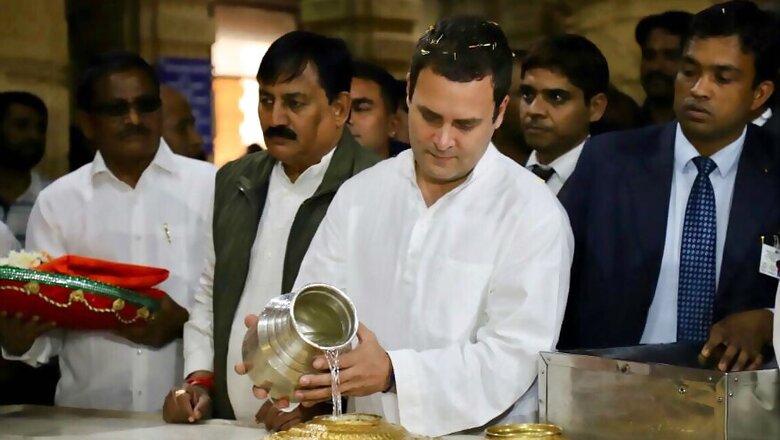
views
One of the new default assumptions in Indian politics appears to be that of a contemporary rural-urban divide between the major parties. The argument essentially runs like this: the Congress Party has been skilful in exploiting rural distress to increase its vote base in the countryside, but the BJP remains rock solid in the cities. This was borne out, it is suggested, in the recent Gujarat assembly polls, where a significant rural wave for the Congress was only overcome by the BJP holding on to their base in the towns.
The corollary of this argument is that the Congress faces a historic new challenge. Thanks to agrarian failures and rural economic stagnation, it can be more successful in rural areas than in 2014, since many rural voters feel the BJP government has done nothing for them. But conversely, the argument runs, the Congress is clueless about how to win over the urban voter. The BJP has managed to consolidate the urban vote, where its traditional support base in the trading community has been augmented by votes from the upwardly-mobile city-dweller, the aspirational youth and the professionals (who also set the social media agenda with their tweets and WhatsApp forwards). Without these segments of the electorate, say our critics, the Congress is doomed — and we don’t know how to woo them.
It is an interesting argument, and whatever its merits, as a Congressman I agree that we need to take it seriously. The urban voter used to be ours, as recently as 2009: one of our biggest challenges in the run up to 2019 would be to win her back. India is urbanising rapidly: the 2011 census proved that the level of urbanisation in India increased from 27.81% in 2001 to 31.16% a decade later, and the proportion of India’s rural population declined from 72.19% to 68.84% between 2001 and 2011. If anything, this trend is accelerating; by 2021 there is likely to be further precipitous increase in the urban population. It’s clear the Congress party needs a strategy to wean these voters away from the BJP.
The party’s well-wishers have another concern. The BJP government’s evident failures in ministering to the needs of rural India represent an obvious political opportunity for the Congress: the mounting farmer suicides, the inadequate funding of the MNREGA, the lack of increase in Minimum Support Prices (MSPs) paid to farmers for vital crops, and the increase in distress migration in the countryside, represent easy targets for the Opposition. But as a result, many Congress well-wishers fear, the party is likely to revert to its tried and tested policies in response, promising massive loan waivers, rural aid packages, increased funding for MNREGA and higher MSPs — which in turn will alienate the urban Indian voter. In other words, the way it exploits the rural vote could cost the Congress more of the urban vote. Agricultural welfarism has always been looked at with suspicion by the urban voter. How can the Congress manage to appeal to the farmer in distress without losing the cities?
Let’s start with the assumption that the BJP’s urban support has become more consolidated since 2014. The principal basis for this contention is that in the Gujarat assembly elections, the BJP recorded a success rate of 82.7% in urban areas, often with huge victory margins. The BJP was long seen as a party of the trading community: these results suggest its support has gone beyond that. It’s also suggested that the city is now home to the “aspirational Indian”, who will vote for the right-of-centre economics advocated by Mr Modi and the BJP.
I respectfully disagree. The fact is that the trading community and the small kirana shopkeeper, long considered the mainstay of the BJP, are deeply unhappy with the party. Indian businessmen have traditionally cared more about their own personal well-being than the country’s overall economy; the aspirational Indians don’t vote ideologically for a rightist programme, rather they judge economic policies by how they affect them individually. The twin hammer blows of demonetisation and the botched implementation of GST have hurt the mercantile community everywhere. In Gujarat, however, they responded to the appeal of Gujarati asmita: Mr Modi was one of their own, he was the first Gujarati Prime Minister, he deserved their support despite his government’s failures. That argument will not work elsewhere, outside Gujarat.
There is thus a historic opportunity for the Congress to reach out to the trading and merchant community across urban India, with the message that their businesses and economic fortunes would be safer in responsible and experienced hands. But their numbers are still modest. What about the urban poor, still the majority of urban voters?
It is true that the decline of industry across India, and the closure of many of the bigger factories and textile mills in the cities, led to the weakening of urban working-class politics and a reduction in the political bargaining power of the working class, which had historically aligned with Congress or the Left but never with the BJP. The transformation of India’s cities in the last 25 years from centres of production to consumer markets has helped the BJP. With the new urban working class largely atomised into small and micro enterprises and petty production, large-scale unionisation became impossible, weakening the Left. Fragmented and scattered workers from the majority community became prey to the BJP tactic of religious polarisation, with voters being told that their interests lay in affirming their communal identity: “only the BJP represents the Hindus.”
The Congress’ answer must lie in a two-pronged strategy. The first is to neutralise the communal appeal by pointing out that we too share Hinduism, albeit an inclusive version of the faith, rather than a bigoted one. The second is to shift the terms of the debate to the basic necessities that urban voters lack. We should speak to and lead the struggle for better public utilities like city transport, pothole-free roads, affordable housing, clean drinking water, decent education in government schools, adequate health care facilities, public parks, cleaner air and improved sanitation and effective waste management.
We should use facts and figures to point out that the BJP’s performance in these basic challenges of urban governance has been woeful and that they do not deserve the votes of the urban public. I would personally go farther and call for a restructuring of urban government, promising to establish directly-elected mayors with real authority and budgetary controls to be able to make a difference to the lives of city residents.
In 2014, the BJP scored across both urban and rural India by focusing principally on governance and development, and relentlessly attacking the Congress government on corruption, economic growth, and price rise (especially of fuel and food). This formula has continued to hold it in good stead in various state elections since, to the point where analysts believe the BJP has replaced the Congress, in Yogendra Yadav’s words, as the “pole around which political competition is organised”. That development actually suits the Congress. We can turn the tables on the BJP by making them accountable for all the economic failures on their watch – both rural and urban.
In an increasingly urbanising India, the rural-urban distinction will become less relevant, not more. Even in rural India, the percentage of non-agricultural employment is increasing. Bringing broadband connectivity to the villages will link rural India through the Internet and smartphones to the same aspirations as urban India. The “revolution of rising expectations” is no longer just an urban phenomenon.
Congress should ask every Indian voter the same simple question: “are you better off than you were in 2014?” The vast majority will respond with an emphatic NO. In that reality lies the Congress’ best prospect of reversing the BJP’s recent dominance.
(The author is Congress MP from Thiruvananthapuram. Views are personal)



















Comments
0 comment